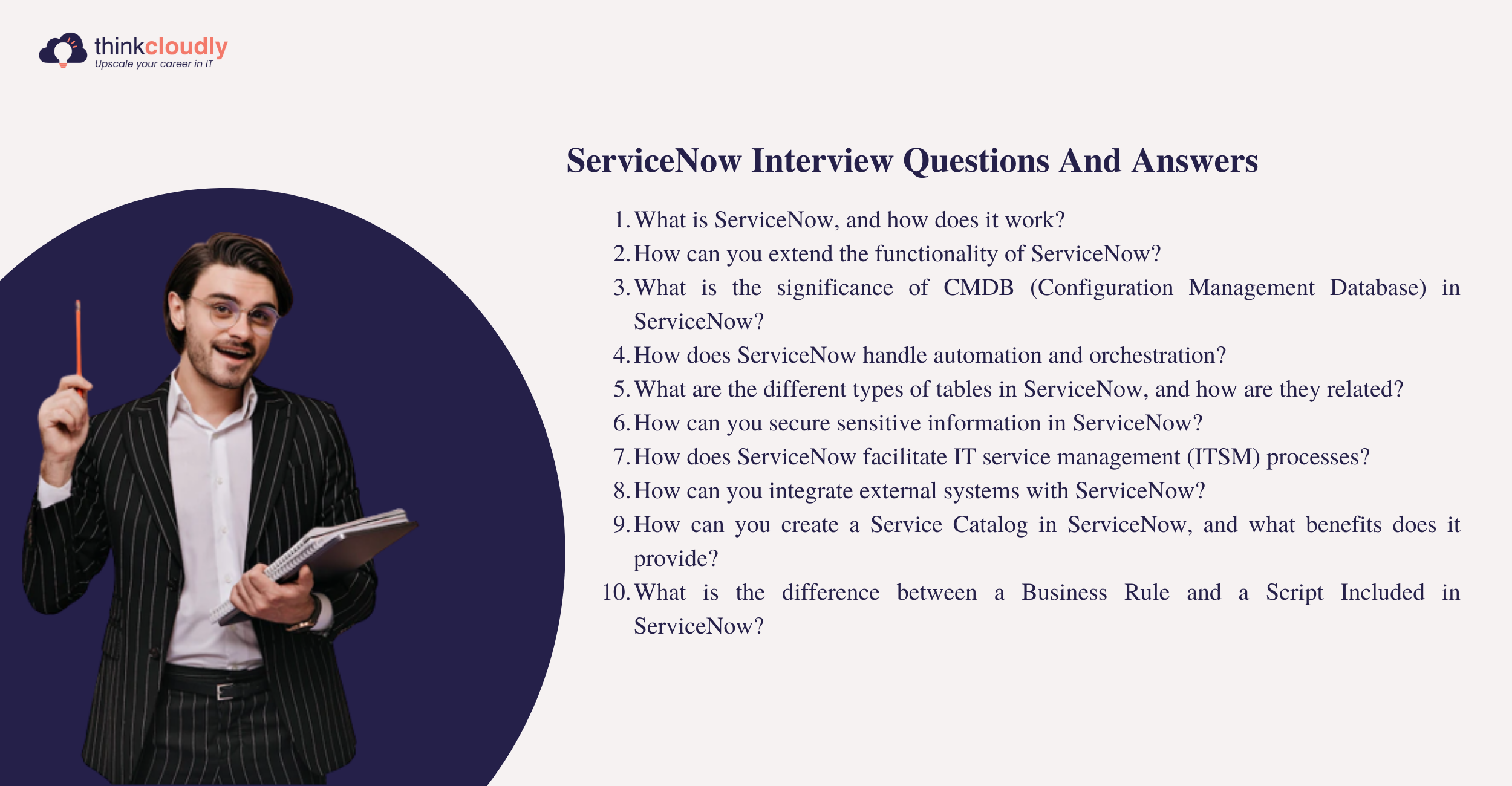Welcome, fellow IT enthusiasts! Whether you are a seasoned professional or a budding ServiceNow developer, preparing for ServiceNow interview questions can be a nerve-wracking experience. Fear not, for we have gathered a collection of engaging and insightful technical ServiceNow interview questions, accompanied by comprehensive answers containing real-world examples. So, grab a cup of coffee, sit back, and dive into the realm of ServiceNow expertise!
It’s essential to prepare for specific roles within the ServiceNow ecosystem. For ServiceNow developer interviews, be ready to discuss topics like scripting, workflow automation, and application development on the platform. ServiceNow integration interview questions often focus on your expertise in connecting ServiceNow with other systems and APIs, so understanding REST and SOAP integration methods can be crucial. For ServiceNow technical interviews, dive deep into topics like platform architecture, data modeling, and performance optimization to showcase your comprehensive understanding of the platform’s technical intricacies. Tailoring your preparation to these specific roles will undoubtedly boost your chances of acing your ServiceNow interviews.
“Navigating ServiceNow Interview Questions with Confidence”
“ServiceNow Business Analyst Interview Questions” and “ServiceNow Interview Questions and Answers” are valuable resources for individuals preparing to navigate ServiceNow job interviews. These curated lists of questions cover a spectrum of topics, ranging from technical skills to situational analysis, enabling candidates to anticipate and excel in interviews. By studying and formulating well-structured answers based on these resources, candidates can demonstrate their expertise in ServiceNow’s platform and processes, ensuring they stand out as capable and knowledgeable contenders for the role.
ServiceNow Interview Questions And Answers
Question 1: What is ServiceNow, and how does it work?
Answer: ServiceNow is a powerful cloud-based platform that offers a range of IT service management (ITSM) solutions. It provides a consolidated view of various IT processes, enabling organizations to automate workflows, streamline operations, and enhance service delivery. With ServiceNow, teams can easily manage incidents, change requests, problem tickets, and more.
Imagine a large organization with multiple departments. ServiceNow acts as the central nervous system, seamlessly connecting these departments and their respective processes. For instance, if a user encounters a software issue, they can submit an incident ticket through the ServiceNow portal. ServiceNow then assigns the ticket to the appropriate IT technician, who resolves the issue and updates the ticket. This integrated approach ensures efficient and transparent communication across the entire organization.
Question 2: How can you extend the functionality of ServiceNow?
Answer: ServiceNow offers various extension points to customize and extend its capabilities. Some notable methods include:
One way to extend ServiceNow is through the creation of custom applications. Let’s say a company wants to automate its employee onboarding process. By developing a custom application on the ServiceNow platform, they can create tailored workflows, forms, and business rules specific to their onboarding requirements. This custom app seamlessly integrates with the existing ServiceNow modules, offering a unified experience to users.
Question 3: What is the significance of CMDB (Configuration Management Database) in ServiceNow?
Answer: The CMDB is a fundamental component of ServiceNow, serving as a centralized repository for storing information about configuration items (CIs). CIs can be hardware, software, network devices, or any other item that is part of the IT infrastructure.
Imagine a scenario where a critical server fails unexpectedly. By referring to the CMDB, ServiceNow can quickly identify the affected server, the applications relying on it, and the users impacted. This allows IT teams to respond swiftly, minimizing downtime and ensuring smooth business operations.
Question 4: How does ServiceNow handle automation and orchestration?
Answer: ServiceNow’s Automation and Orchestration module enables organizations to automate manual tasks and streamline complex workflows. It helps reduce operational costs, improve efficiency, and enhance service delivery.
Let’s consider the process of provisioning a new virtual machine (VM) in a cloud environment. Using ServiceNow’s Automation and Orchestration module, you can create a workflow that automates the entire process. The workflow can involve various tasks, such as requesting resources, verifying approvals, provisioning the VM, and notifying the user upon completion. This automation eliminates the need for manual intervention, reduces errors, and accelerates the provisioning process.

Build Your Career as a
ServiceNow Developer
- Live Projects
- Resume / Interview Preparation
Question 5: What are the different types of tables in ServiceNow, and how are they related?
Answer: ServiceNow utilizes various types of tables to organize and manage data effectively. Some common types of tables include:
- Core Tables: These tables store essential information, such as users (sys_user), groups (sys_user_group), and incidents (incidents). They form the foundation of ServiceNow’s data model.
- Configuration Tables: Configuration tables store information about different configuration items (CIs) in the CMDB. Examples include computers (cmdb_ci_computer), servers (cmdb_ci_server), and software (cmdb_ci_software).
- Custom Tables: Organizations can create custom tables to store additional data specific to their business processes. For example, a company might create a custom table to track hardware assets.
- Extension Tables: Extension tables extend the functionality of existing core tables without modifying the base structure. They allow organizations to add custom fields or business rules to meet their unique requirements.
Question 6: How can you secure sensitive information in ServiceNow?
Answer: ServiceNow provides several mechanisms to secure sensitive information:
- Access Control: ServiceNow employs role-based access control (RBAC) to grant or restrict access to different parts of the system. By assigning appropriate roles and permissions, organizations can ensure that only authorized individuals can view or modify sensitive data.
- Data Encryption: ServiceNow offers data encryption capabilities to safeguard sensitive information stored in the system. Encryption protects data at rest and in transit, ensuring its confidentiality and integrity.
- Field-Level Security: Administrators can define field-level security rules to control who can access or modify specific fields within a table. This allows organizations to restrict access to sensitive data fields based on user roles and requirements.
Boost your earning potential with ServiceNow expertise. Explore our certified ServiceNow Courses for a high-paying career
Question 7: How does ServiceNow facilitate IT service management (ITSM) processes?
Answer: ServiceNow offers comprehensive ITSM capabilities to streamline and automate IT service processes. Some key features include:
- Incident Management: ServiceNow enables organizations to track and resolve incidents efficiently. It provides workflows to assign, prioritize, and escalate incidents, ensuring timely resolution and minimizing disruptions.
- Change Management: ServiceNow’s Change Management module allows organizations to manage changes to their IT infrastructure effectively. It provides a structured approach for planning, reviewing, and implementing changes, reducing the risk of service disruptions.
- Problem Management: ServiceNow’s Problem Management module helps organizations identify and address the root causes of recurring incidents. It facilitates the investigation, diagnosis, and resolution of underlying issues, improving service stability.
Question 8: How can you integrate external systems with ServiceNow?
Answer: ServiceNow supports various integration methods to connect with external systems:
- Web Services: ServiceNow exposes web services (SOAP and REST) that allow seamless communication with external systems. You can use these web services to send or retrieve data, trigger actions, or synchronize information between ServiceNow and other applications.
- MID Server: The MID Server acts as a communication proxy between ServiceNow and external systems residing within an organization’s network. It enables ServiceNow to connect with systems behind firewalls or in restricted network zones.
- Integration Hub: ServiceNow’s Integration Hub provides pre-built connectors and workflows to integrate with popular third-party applications. It simplifies the integration process by offering out-of-the-box configurations and reusable components.
Question 9: How can you create a Service Catalog in ServiceNow, and what benefits does it provide?
Answer: To create a Service Catalog in ServiceNow, follow these steps:
- Define catalog items: Identify the services you want to offer and create catalog items for each service. Catalog items can represent tasks, requests, or offerings.
- Design the catalog: Organize catalog items into categories and subcategories to improve navigation and user experience.
- Configure variables: If your catalog items require user input, define variables to capture the necessary information. Variables can be dropdown lists, checkboxes, text fields, etc.
- Create workflows: Establish workflows that govern the approval, fulfillment, and tracking of catalog requests.
- Publish the catalog: Once configured, publish the Service Catalog so that users can access and request services.
Benefits of the Service Catalog:
- Streamlined Service Request: The Service Catalog allows users to browse and request services easily, reducing the need for manual requests and improving efficiency.
- Standardization: By defining clear catalog items and associated workflows, organizations can standardize service delivery processes and ensure consistent experiences for users.
- Self-Service: The Service Catalog promotes self-service, enabling users to find and request services independently, reducing dependency on IT personnel, and freeing up resources.
- Transparency and Tracking: The catalog provides transparency into the status of service requests, allowing users to track the progress of their requests and stay informed.
Question 10: What is the difference between a Business Rule and a Script Included in ServiceNow?
Answer: Business Rule:
- Business Rules are server-side scripts that run when specific conditions are met.
- They operate at the database level and trigger actions, such as updating records, setting field values, or displaying messages.
- Business Rules are designed to execute automatically and can be configured to run before or after record operations (insert, update, delete).
- They are useful for enforcing data consistency, implementing validations, or performing calculations during record operations.
Script Include:
- Script Includes are reusable server-side scripts that can be called from various client or server-side scripts.
- They encapsulate a set of functions and can be utilized across multiple applications or modules within ServiceNow.
- Script Includes promoting code modularity, reusability, and maintainability.
- They are commonly used for complex business logic, data manipulation, or integrations.
Example:
Let’s consider a scenario where you want to enforce a business rule that calculates the total cost of a purchase order (PO) based on the quantity and unit price. Additionally, you want to reuse this calculation logic in other areas of the system.
Business Rule: Create a business rule on the Purchase Order table that triggers after an update. In the script, calculate the total cost by multiplying the quantity and unit price fields and updating the Total Cost field on the PO record.
Script Include: Create a script include called “POUtils” with a function named “calculateTotalCost(quantity, unitPrice).” This function performs the calculation and returns the result. In the business rule, call the “calculateTotalCost” function from the script include to update the Total Cost field.
Conclusion:
We have only scratched the surface of the vast world of ServiceNow in this blog. As you prepare for your ServiceNow interview, remember to grasp the concepts and examples provided. Delve deeper into ServiceNow’s capabilities, explore real-world scenarios, and don’t hesitate to experiment with the platform. Armed with knowledge and hands-on experience, you’ll undoubtedly stand out in your ServiceNow interviews. Stay curious, stay motivated, and ace that interview!
We hope you found this blog engaging and informative. Stay tuned for more captivating content on ServiceNow and other cutting-edge technologies.











